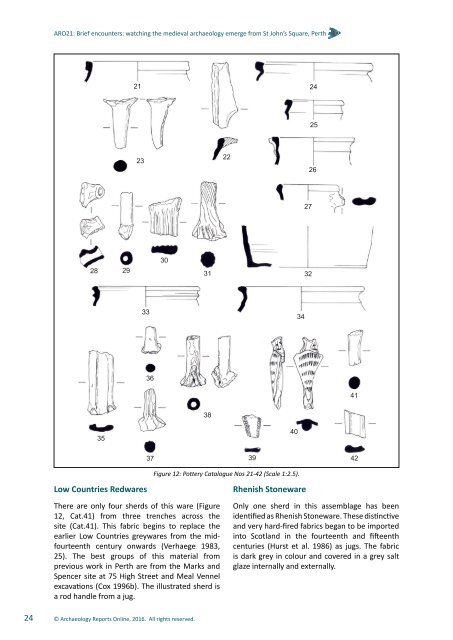medieval archaeology emerge from St John’s Square Perth
ARO21_St_Johns_Square
ARO21_St_Johns_Square
Create successful ePaper yourself
Turn your PDF publications into a flip-book with our unique Google optimized e-Paper software.
ARO21: Brief encounters: watching the <strong>medieval</strong> <strong>archaeology</strong> <strong>emerge</strong> <strong>from</strong> <strong>St</strong> <strong>John’s</strong> <strong>Square</strong>, <strong>Perth</strong><br />
<br />
<br />
<br />
<br />
<br />
<br />
<br />
<br />
<br />
<br />
<br />
<br />
<br />
<br />
<br />
<br />
<br />
<br />
<br />
<br />
<br />
<br />
Figure 12: Pottery Catalogue Nos 21-42 (Scale 1:2.5).<br />
Low Countries Redwares<br />
There are only four sherds of this ware (Figure<br />
12, Cat.41) <strong>from</strong> three trenches across the<br />
site (Cat.41). This fabric begins to replace the<br />
earlier Low Countries greywares <strong>from</strong> the midfourteenth<br />
century onwards (Verhaege 1983,<br />
25). The best groups of this material <strong>from</strong><br />
previous work in <strong>Perth</strong> are <strong>from</strong> the Marks and<br />
Spencer site at 75 High <strong>St</strong>reet and Meal Vennel<br />
excavations (Cox 1996b). The illustrated sherd is<br />
a rod handle <strong>from</strong> a jug.<br />
Rhenish <strong>St</strong>oneware<br />
Only one sherd in this assemblage has been<br />
identified as Rhenish <strong>St</strong>oneware. These distinctive<br />
and very hard-fired fabrics began to be imported<br />
into Scotland in the fourteenth and fifteenth<br />
centuries (Hurst et al. 1986) as jugs. The fabric<br />
is dark grey in colour and covered in a grey salt<br />
glaze internally and externally.<br />
24<br />
© Archaeology Reports Online, 2016. All rights reserved.


